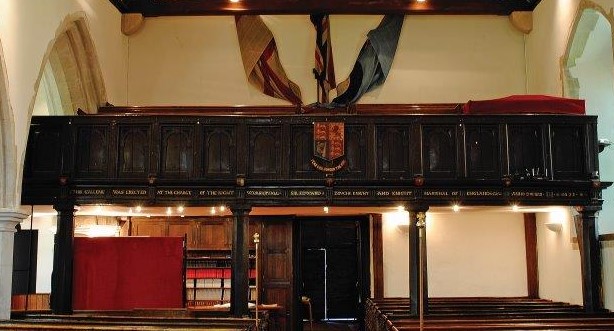Zouche Gallery

2022 sees the 400th anniversary of the installation of our splendid Jacobean panelled oak gallery at the west end of the church. The gallery originally stopped short of the south aisle but was extended in the late 19th century. One unfortunate consequence of the installation of the gallery was that it stopped our famous and very rare Norman door from opening, so the top of the door had to be removed from the rest of it and fixed in place, so that the door could continue to function. The gallery would have originally been used by minstrels in the days before church choirs were introduced. If you are wondering where the minstrels performed before 1622, there used to be a rood loft over the entrance to the chancel-all that remains now is a stone staircase leading to nowhere!
The gallery was gifted to St Peter’s by one of the most prominent courtiers at the court of King James I, gentleman of the Privy Chamber Sir Edward Zouch. Sir Edward was a well-married man, having already married twice before marrying his third and final wife, Dorothy Silken in 1612. Dorothy was a Danish gentlewoman in the bedchamber of Anne of Denmark, wife of King James. A chaplain at court later wrote that Dorothy was a ‘homely woman’ and that Sir Edward only married her for her money; it is certainly true that his wife’s dowry enabled Sir Edward to move up in the world, as in 1618 he was able to purchase the office of Knight Marshall for £3000 from Sir Thomas Vavasour, an achievement that Sir Edward made sure would be remembered for posterity by having it inscribed on the front of the gallery.
Sir Edward was able to purchase the Knight Marshallship because King James I gave him £1500 towards the cost, which shows how high he stood in the king’s favour. In fact such was King James’ confidence in Sir Edward, he entrusted him with the funeral arrangements of the king’s wife in 1619. One reason that King James enjoyed Sir Edward’s company may have been the latter’s theatrical talent. After engaging in glass-making from 1609 to 1618, Sir Edward found a new calling, that of the thespian. He acted in a number of plays performed for the theatre-loving king, all of which were comedies, one, called ‘Tom of Bedlam the Tinker’ being a little too rude even for the king’s tastes.
Sir Edward certainly knew how to entertain King James and keep him happy. When the king gave him the manors of Woking, Bagshot and Chobham in 1620, Sir Edward made sure that Woking Park was well stocked with game for the king to hunt when he visited Woking in 1624. In fact King James so enjoyed hunting Sir Edward’s ‘Great Stags’ that he extended his visit to Woking far longer than expected. Nevertheless, despite the popularity of Woking Palace with the king and many of his royal predecessors, the site was not to Sir Edward’s liking, possibly due to the damp caused by it’s proximity to the River Wey. He allowed the palace to fall into ruin and used materials from the building to build a new house, New Hoe Place (now a school). It has been suggested that Sir Edward might in fact have taken our gallery from Woking Palace too, as before being extended it would have fit in either the King’s Hall or Great Hall, but this cannot be proved.
When Sir Edward died in 1634, his gallery was not the only monument to him in St Peter’s. He was buried in the chancel and his wife erected a bronze memorial to him, written in Latin and set in green marble on the south wall of the chancel. The inscription describes Sir Edward as “a most noble and glorious gentleman, a golden knight of their most serene Majesties King James and King Charles, a princely Marshal for as long as he lived.” It ends: “The better of him has reached heaven, whence it originally came. Our sense of loss and his reputation outlive this world. His grieving spouse rightly mourns the best of husbands.” This might not, however, be how Sir Edward’s tenants saw him. In his will he asked to be buried at midnight, so that no one would see his coffin. This may have been out of fear of a disturbance at his funeral (or even worse, possible desecration of his tomb) by local people angered by his mis-management of Woking Manor. Which brings us back to our wonderful gallery: It is possible that Sir Edward gifted his gallery to St Peter’s in an attempt to regain the favour of the good people of Woking…